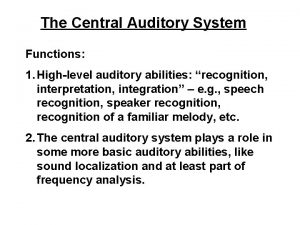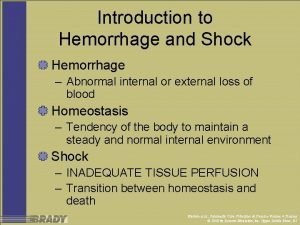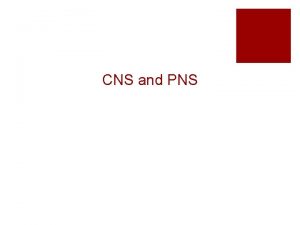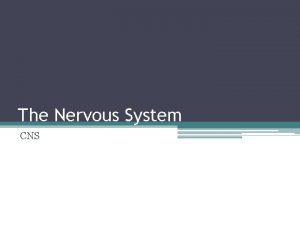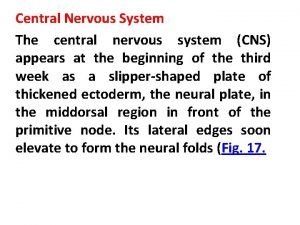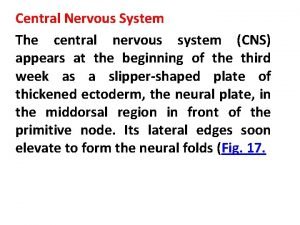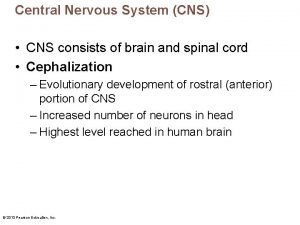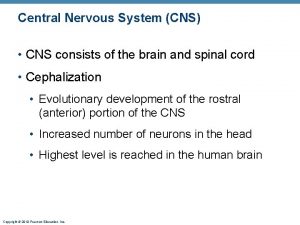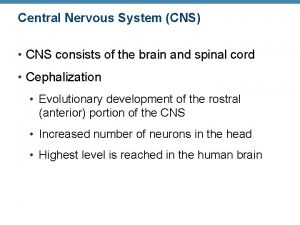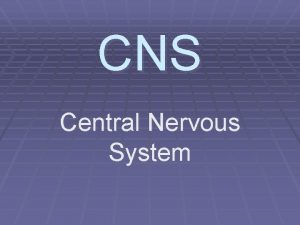Nervous System AThe central nervous system CNS is













- Slides: 13

Nervous System A)The central nervous system (CNS) is composed of the 1. Brain 2. spinal cord.

B)Peripheral nervous system (PNS) is made up of Peripheral nerves that connect the CNS to the rest of the body. • 12 pairs of cranial nerves • 31 pairs of spinal nerves

Peripheral Nervous System • PNS can be subdivided into 2 divisions: • (1) Autonomic • (2) Somatic • (1) Autonomic • Cranial & spinal nerves connecting CNS to heart, stomach, intestines, glands • Controls unconscious activities

• Autonomic division of the nervous system can be subdivided into 2 divisions: (1) Parasympathetic – Decreases heart rate, bronchiole dilation, blood glucose, blood to skeletal muscle – Increases digestion, pupil size, urinary output – “rest and digest” (2) Sympathetic – Decreases digestion, pupil size, urinary output – Increases heart rate, bronchiole dilation, blood glucose, blood to skeletal muscle – “fight or flight”

Peripheral Nervous System • (2) Somatic Cranial & spinal nerves connecting CNS to skin & skeletal muscles


Organization of Nervous System Central Nervous System Peripheral Nervous System Brain & spinal cord Autonomic N. S. Parasympathetic Somatic N. S. sympathetic

Parasympathetic vs. Sympathetic Divisions

Nervous Tissue is composed of two major cell types: neurons and neuroglial cells. Neuroglial cells provide physical support, insulation (myelin), and nutrients for neurons.

Neurons are made up of a cell body, dendrites, and axons. Dendrites receive information. Axons send information. Larger axons are enclosed by sheaths of myelin produced by Schwann cells. Narrow gaps in the myelin sheath between Schwann cells are called nodes of Ranvier.

Classification of Neurons • (1) Multipolar • Many processes arising from cell body • Brain or spinal cord • (2) Bipolar • 2 processes (1 from each end of cell body) • Ear, eyes, nose • (3) Unipolar • Single process extends from cell body • Outside of brain & spinal cord

• Classifying by Function: Sensory Neurons – (afferent) have specialized receptor ends that sense stimuli and then carry impulses from peripheral body parts to brain or spinal cord. Can be unipolar or bipolar. Interneurons – lie entirely within the brain or spinal cord; direct incoming sensory impulses to appropriate parts for processing and interpreting. Motor Neurons – (efferent) carry impulses out of the brain or spinal cord to effectors (muscles, glands).

Nerves are cable-like bundles of axons.
 Fundamentals of the nervous system and nervous tissue
Fundamentals of the nervous system and nervous tissue Sensory input and motor output
Sensory input and motor output Nerve cell processes
Nerve cell processes Division of central nervous system
Division of central nervous system Central nervous system amusement park
Central nervous system amusement park Central nervous
Central nervous Nervous tissue
Nervous tissue Central and peripheral nervous system
Central and peripheral nervous system Bser aer
Bser aer Neuroglia
Neuroglia Central nervous system for kids
Central nervous system for kids Ltpd抽樣表
Ltpd抽樣表 Naas cns
Naas cns Cns ischemic response
Cns ischemic response








